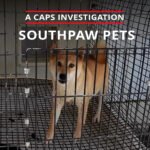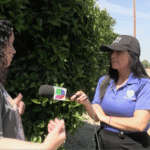Breeder: Cooper, Ronnie and Patricia
Address: 4051 535 Rd
City, State Zip: Darlington, MO 64438
Year: 2004
USDA License: 43-A-2945
USDA Inspector: Rexford Dannull, ACI
USDA Inspections: 2003-03-20
Date of CAPS Investigation: 2004-10-05
Approximately 70 dogs and 20 puppies. Breeds: Rottweilers, Basset Hounds, Beagles, Labradors, German Shepherds, Maltese, Jack Russell Terriers, Shih Tzus, Schnauzers
Larger barn and indoor pens
One of Ronnie and Patricia Cooper’s kennel buildings, which was about 300 feet north of the house, was a barn about 50 feet long and 20 feet wide. The inside of the barn had plastic sheeting on its wall and concrete flooring. There was a refrigerator near the doorway, a table covered with bottles of medicine, and about two dozen bags of food stacked in the center of the room (3.1(e)-Storage). The feed bags were directly next to the table, and the medicine bottles were left open on the table instead of being stored in a cabinet (3.1(e)-Storage). Eight windows, each about a foot wide and tall, were along the walls of the barn. The building had lights and an air conditioning unit.
Fully enclosed painted wooden boxes, each about 2.5 feet wide, 2.5 feet long, and about 1.5 feet high, were adjacent to each other in a row on the northern wall. The boxes had double cabinet doors on the southern sides, but it was not clear if these boxes were indoor cages for the raised outdoor cages on the northern side of the building.
Three indoor cages against the western wall were each about six feet wide, and eight feet long. They had six-foot-high painted wooden walls and six-foot-high doors of treated, galvanized wire. Doggie doors accessed outside cages. The doggie doors, placed about six inches above the floor, had no wooden ramps leading up to them. Carpets covered the concrete floorings of the pens, and heat lamps were near the tops of the pen walls.
The southern pen of this group of pens housed a nursing adult Labrador with seven puppies about four-weeks-old. An uncarpeted area about two feet wide and two feet long was covered in feces (3.11(a)-Cleaning of primary enclosures).
Eight Basset Hound puppies about six-weeks-old were in the middle pen of this group of pens. A metal self feeder was north of the doggie door. Two metal pans were on the carpeted flooring, one containing food and the other water. The carpets were completely covered and stained with more than 24 hours’ accumulation of feces (3.11(a)-Cleaning of primary enclosures).
Another row of painted, connected wooden boxes were on the southern side of the building. The boxes had doors on the southern ends, and they appeared to be the indoor cages for the outdoor pens on the southern side of the barn.
Outdoor pens on south side of barn
Four outdoor cages were on the southern side of the barn. These cages were about three feet wide, six feet long, and five feet high. The pens had untreated and rusting, thick-gauge galvanized wire for their walls and roofs and concrete floorings (3.1(c)(1)(i)-Surfaces). Each pen had a metal doggie door in it against the barn wall. A wooden ramp led to the door. There was a plastic water dish containing brown water on the floor of each pen (3.10-Watering).
The southern pen contained three adult Miniature Schnauzers who had thick mats in their fur (2.40-Vet Care). The other pens contained adult Beagles. There was a camouflage covering on the roofing of the pens and a liquid-filled bottle sitting on the eastern edge of the roof of the eastern pen (3.1-Condition and site).
Outdoor pens on the east side of barn
Four outdoor cages on the eastern side of the building had open doggie doors connecting to the inside pens. Each pen held one to two adult Beagles.
The corners of each cage were made of wooden beams. The walls of the southernmost pen were made of untreated chicken wire (3.6(a)(2)(xii)-Primary enclosures). The two middle pens had chain link walls separating them from their adjacent pens and thick-gauge galvanized wire on the eastern wall. The northernmost pen had chain link wire on its north side and wooden beams creating the eastern wall.
The pen floorings were concrete. Roofing extended about five feet over the pens from the barn. Each pen had a plastic water dish on the flooring near the door. In the southernmost pen, a piece of carpet measuring eight feet by five feet covered a section of the southern wall. Vines were growing around the roofing and northern wall of the northernmost pen (3.1(b)-Condition and site).
Rottweiler pen
Northeast of the indoor/outdoor pens was an outdoor pen, about 30 feet long and about 20 feet wide, housing two female and two male adult Rottweilers.
This pen was adjacent to a barn with red metal siding, and a four-foot-high fencing of untreated, thick-gauge wire created the other three sides of the pen. A 4.5-foot-high chain-link wall extended about 10 feet from the barn and had vines growing on top of it and hanging over its sides (3.1(b)-Condition and site.)
The pen had a dirt flooring with more than two weeks’ accumulation of feces on it (3.1 (c)(3)-Cleaning) (3.11(a)-Cleaning of primary enclosures). A painted, wooden dog house, about three feet wide, five feet long, and three feet high, was near one corner of the pen. Several metal food and water dishes on the ground were not placed so as to minimize contamination by excreta or pests (3.9(b)-Feeding). A wheel barrel, shovel, and several six-foot-long metal rails were against the northern fence (3.1(b)-Condition and site).
Basset Hound pens
West of the Rottweiler pen were two outdoor Basset Hound pens spaced about 2.5 feet apart. The eastern pen was about six feet from the Rottweiler pen. Each pen, about four feet wide, six feet long, and four high and raised about a foot above the ground on wooden stilts, housed two Basset Hounds.
Part of these pens, an area about five feet long and three feet wide, had wooden beams for corners and untreated, thin-gauge galvanized wire for walls and roofs (3.6(a)(2)(xii)-Primary enclosures). Floorings were made of treated wire.
The remaining section of each pen contained a fully enclosed wooden box with plastic doggie-doors providing access. Most of the roof of each pen, a five-foot section, was covered by metal sheets over the wire. A single metal self feeder was attached to the side of each pen, and water dishes were on the pen floorings. Under both pens was more than two weeks’ accumulation of feces in piles five feet long, three feet wide, and up to four inches high (3.11(a)-Cleaning of primary enclosures).
Additional outdoor pens
Three pens in a row were located within 2.5 feet of the previously described Basset Hound pens. Each pen was about four feet wide, ten feet long, and six feet high and had untreated, thick-gauge galvanized-wire walls, concrete floorings, and sheet-metal roofs completely covering the tops of the pens. The western pen contained three Basset Hounds, and two Jack Russell Terriers ran in and out of the dog house in the center pen.
The backs of each pen had a wooden dog house about four feet wide, four feet long, and about three feet tall. The sides of these houses angled up from the floor making the roofs of the houses about three feet wide. Each dog house had a plastic doggie door. A wooden board about four feet high and seven feet long separated the bottoms of the center and eastern pens.
Metal self feeders were attached to the dog houses about an inch from the ground. The feeders were not placed so as to minimize contamination by excreta or pests (3.9(b)-Feeding). There were metal dishes filled with dark brown water on the floor of each pen (3.10-Watering).
Outdoor cages against the barn
South of the pens described above were six outdoor cages positioned along the northern wall of the larger barn. These adjacent cages were about 2.5 feet wide, 2.5 feet long, and about two feet high. Painted wooden beams framed each cage, and painted wooden stilts raised the cages about three feet off the ground. There were two adult Shih Tzu in one cage, and an adult Beagle in the cage adjacent to them.
Each cage had a treated-wire flooring and walls made of untreated and rusting thin-gauge galvanized wire (3.6(a)(2)(xii)-Primary enclosures) (3.1(c)(1)(i)-Surfaces). The northern cage walls included access doors. An angled metal roof covered the pens, and an angled metal sheet was positioned about 1.5 feet below the pens to catch feces and debris. The sheet angled down to a ditch in the ground, about 15 feet long and a foot wide, that was filled with water and feces and swarming with flies (3.1(f)-Drainage and waste disposal) (3.11(d)-Pest Control). There was a water dish on the flooring of one pen, but other dishes were blocked from view by the dogs.
Second, smaller barn
South of the larger barn was a barn about 30 feet wide and 30 feet long. It had a peaked metal roof and white metal siding and doorways on the east and west sides. Inside the barn, thick cobwebs covered the walls of the pens and ceiling of the barn (3.11(c)-Housekeeping for premises). Dust was clearly visible in the air (3.2(b)-Ventilation).
There were three pens on the north side and three pens on the south side inside this barn. A walkway was between them. Each pen was about eight feet wide and ten feet long. The pens were made of wooden boards and untreated, thick-gauge galvanized wire.
None of the lights near the roof of each pen were on, so it difficult to determine how many dogs were in each pen and what breeds they were (3.2(c)-Lighting).
Smaller barn outdoor pens
Outside the southern side of the smaller barn were four pens, each about six feet wide, six feet long, and about four feet high. The pens were surrounded by chain-link walls, had concrete floorings, doggie doors accessing the southern indoor pens of the barn, and water dishes on the floors. The easternmost pen had two adult Maltese. Seven adult Maltese were in the pen next to it, and another two Maltese in each of the other pens. An area of dirt ground about 24 feet long and a one foot wide south of these pens was covered in standing water and feces (3.1(f)- Drainage and waste disposal).
More outdoor pens
At the eastern end of the property, within 100 feet of the house and positioned on the grass lawn, were three chain-link pens about three feet wide, six feet long, and five feet high. One pen housed two Labradors and a German Shepherd, each about six-weeks-old. The pen had no dog house or shelter, no roof covering, and no wind/rain breaks (3.4(b)-Shelter from the elements). On the grass were two water dishes and a food dish, which was not placed so as to minimize contamination by excreta or pests (3.9(b)-Feeding).




